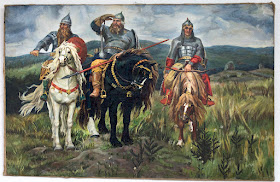Something else happens during his reign that I have to assume is not a coincidence, and that he encouraged it: the rise of the Kievan Cycle, legends about heroes, some of whose origins can be traced to real people during Vladimir's reign among his elite warriors and personal companions.
Now for some terms: a bogatyr (etymology uncertain) is a hero, a knight errant similar to Arthur's knights of the Round Table who travel the land having adventures recorded in the Rus' epic poems called bylinas (from the past tense of the Russian verb for "to be," indicating "something that was"). Prior to Vladimir's reign and the Kievan Cycle, Slavic/Russian legends include supernatural elements; the bogatyr often wield magic. The Kievan Cycle is more rooted in fact and national pride. The heroes are often depicted in defending the homeland.
One of the bogatyr is Dobrynya, shown to be based on Vladimir's maternal uncle of the same name. Vladimir had been sent to Dobrynya in Novgorod as a youth. One story claims that Vladimir's rape of Rogneda (see the link above) was orchestrated by Dobrynya, after Rogneda insulted his sister, Vladimir's mother Malusha. It was Dobrynya who forced Novgorod's Christian conversion "by fire" after Vladimir's decision.
The picture above is an 1898 painting the three best-known bogatyr: Dobrynya Nikitich, Ilya Muromets, and Alyosha Popovich. Bogatyr were sometimes known for specific characteristics. Dobrynya was known for his courage, Alyosha for his wits, and Ilya excelled in strength and integrity and his defense of the homeland.
Tomorrow we'll delve into some of the fictional and not-so-fictional bogatyr and their bylinas.

No comments:
Post a Comment
Note: Only a member of this blog may post a comment.